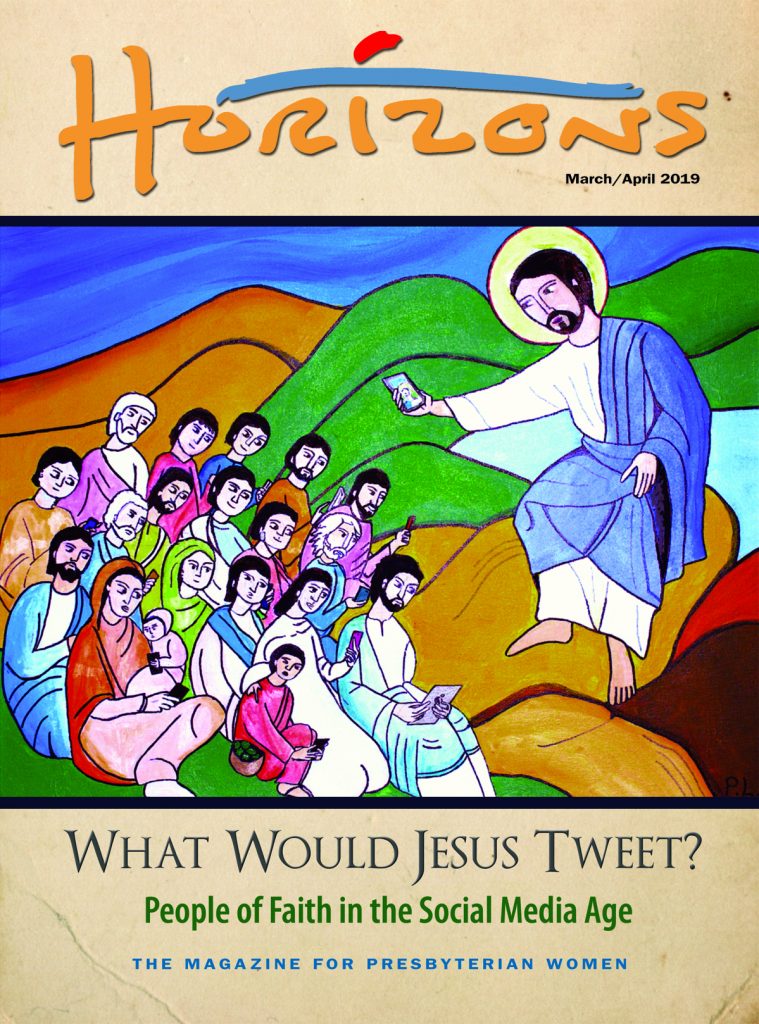Horizons: March/April 2019

“What Would Jesus Tweet?”
That question—and the underlying questions of how much pull the internet and social media has (or should have) on our lives—elicits some strong responses: everything from “He wouldn’t! He’d talk to the person next to him!” to “The beatitudes are immanently tweetable.”
The conflicted responses to these questions are why the cover image seemed like such a good fit for this issue. Does the cover image unsettle you? Make you chuckle? Is it the crowd’s use of phones or Jesus’ that sparks your response? Does it make you want to reach for your smart phone or toss it in the nearest lake (but then drive to the tech recycling bin)?
Regardless of our personal level of comfort with social media—or the internet at large—it’s here to stay for the foreseeable future. So as people of faith, what does our use of social media look like? How can we use it and shape it to reflect the best of who we are?
Facebook executive Sheryl Sandberg recently said, “New technologies always bring really big challenges with them. You can read about things—from the printing press to the railroads, to TV, to the radio—and when you read about them, they sound exactly like they are talking about the internet or social media. Every new technology goes through these periods where you have this huge influx of joy and optimism around what technology can be. And then a period where people are genuinely, and a lot of times for good reason, worried about some of the harms. And then it’s followed by a period of deeper reflection and learning. And in those periods, I think we are going to figure out really what kind of internet we want. . . . And I think during these periods where it is the hardest, that’s when diverse perspectives are even more important.”
We’re definitely in a period of weighing pros and cons regarding social media platforms (including Facebook), and perhaps the internet in general. These tools give us more possibility for connection than ever before, but also make possible expressions of hatred and violence. A single platform can be life-giving for one person, but be a threat to someone else.
As Laura Mariko Cheifetz explains, it’s Twitter and Facebook that bring together often silenced advocates and allies who can expand our understanding and practice of justice. Cheryl Leanza raises important concerns about how gaps in policy (or application of policy) for various websites allow hate to fester and spread on the internet. But those same websites are some of the ones that people of faith use every day to build communities rooted in love, welcome and support. For example, as Karen González describes, it’s Twitter that helped her find a community of progressive Latinx people when she felt alone. Or as Mari Graham highlights, it’s Facebook that can allow a church or PW group to reach new people. These writers and the other contributors to this issue celebrate the possibilities of social media while also noting the very real concerns it presents. In short, they help us navigate our way through this period of reflection about social media, helping us chart a course for how we as people of faith engage social media.
Already a subscriber? Log-in to read this issue.
Features
Exploring the Twitterverse
Laura Mariko Cheifetz examines the strengths and drawbacks of Twitter. She highlights trends on the platform that are relevant to people of faith—from misinformation and harassment to advocacy and broader inclusion. #roadmap
Online Hate Speech: What the Faith Community Can Do
Social media and the internet at large have structural flaws that allow hate speech to proliferate and even earn profit. Cheryl Leanza highlights these flaws and the response of advocates and the faith community helping curtail hate speech. #changetheterms
Finding Followers: Using Social Media to Build Community
Mari Graham has seen lots of faith-based Facebook accounts, and has seen the way this social media platform can draw in new people. She suggests best practices for managing a church’s or PW’s Facebook presence. #tipsandtricks
Connection, Amplification and Community: The Benefits of Social Media
Karen González shares her experience of finding community on line as a Christian of color. She details how social media facilitates virtual community (and sometimes also in-person community!) for people of color who feel theologically, politically or even professionally alone. #kindredspirits.
PW Resources
Installation Service for Presbyterian Women
Created, Called, Loved #nofear
Cheri Harper
2018 Honorary Life Membership Recipients #forallyoudo
Bible Study Resource
Roula Alkhouri offers reflections and questions for use in studying Lesson Nine of the 2018–2019 PW/Horizons Bible study, God’s Promise: I Am with You by Amy Poling-Sutherlun. #mytruth
Departments
Devotion
A Timeless Faith in This Time #twofish
Cecilia Amorocho Hickerson
Unpacking the Theme: Scripture Study
The Social (Media) Is Political #letstalk
Mihee Kim Kort
After the Offering
When Small Becomes Large #bettertogether
Susan B. Wilson
What One PW Is Doing
Live, on Facebook, It’s PW! #goodtoseeyou
Shari Stump
Stories from the Ages
The World at Our Fingertips #cakeandmom
Hillary Moses Mohaupt
Faithful Parenting
Considering Our Legacy #deepwater
Amy Starr Redwine
Supporting Mission
Hands-on Project Sends Love to Children in Puerto Rico #projectpillowcase
Cheri Harper
Working for Justice and Peace
PW’s Substance Use Disorder (SUD) Initiative #publichealth
Marvella Lambright
Mosaic
News and Information About Presbyterian Women and the Presbyterian Church (U.S.A.) #tellyourfriends
Books
Pages Worth Turning #nowreadthis
Strengthening the PC(USA)
What Would Jesus (Have Us) Tweet? #wwjt
Cindy Kohlmann
